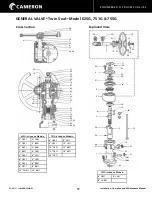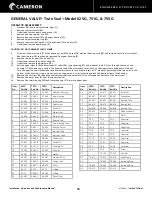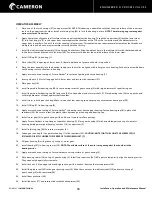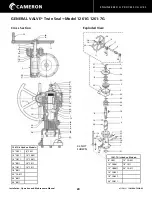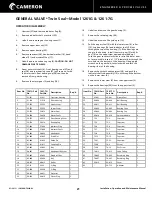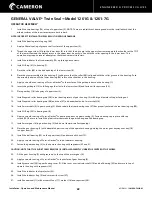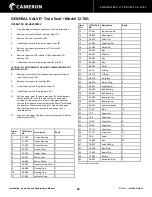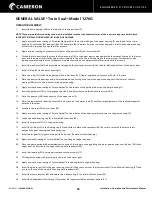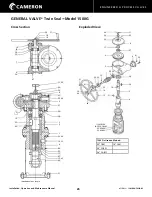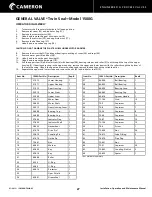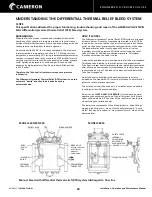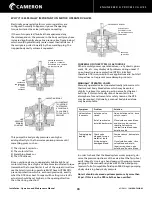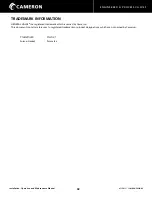
E N G I N E E R E D & P R O C E S S V A L V E S
07/2011 / IOM-GEN-TWIN-03
31
Installation, Operation and Maintenance Manual
The Twin Seal valve requires no day-to-day maintenance,
however, there are some services which may be needed oc-
casionally.
ANNUALLY
1.
Drain plugs in the lower plate should be
removed and the residue flushed and drained from
the lower plate. In cold climates, before freezing
weather sets in, any possible collection of water
below valve plug or plug trunnion should be
drained out through the lower plate drain plugs.
SEMI-ANNUALLY
a.
Keep the valve operator housing full of lubricant to
displace and prevent moisture from accumulating
and freezing. The operator is provided with a
grease fitting. Lubricant should be injected with
the Twin Seal valve in the
open
position
only. Under ordinary conditions, a few
pumps of the grease gun semi-annually is sufficient.
Use lithium 12 hydroxy stearate or lithium base
molydisulfide grease.
SEMI-ANNUALLY
b.
If applicable, temporarily remove ABBV cover and
guide pin. Liberally apply grease in this area
semi-annually.
IF AT ANY TIME...
2.
If at any time the body bleed should indicate a leak
which cannot be stopped with ordinary force on
handwheel (no cheaters necessary), this may be
corrected by one of the following:
a)
Operate valve through open-close cycle while fluid
is flowing to flush out valve body. After several
flushing attempts, close the Twin Seal valve and check
body bleed again. If body bleed still indicates valve
leakage, proceed to b).
b)
If the valve is supplied with a DTR system, it is
possible that the relief valve may be leaking. Check
this by temporarily closing the line isolation valve.
If the leak stops, repair or replace the relief valve. If
this is not the case, the slips need inspection.
c)
To inspect or replace slips the line must be drained.
Then place the Twin Seal valve in the open position
(check body bleed valve for zero line pressure) and
remove lower plate (lower plate can be driven off by
closing valve, inserting a wedge and then opening
valve again). Slips can be removed from plug and
inspected or replaced if damaged. Be sure to save the
old slips and return to Cameron for exchange credit.
It is recommended to replace the lower plate O-Ring
and gasket any time the lower plate is removed and
slips are replaced.
If the lower plate is not accessible for replacing seating slips,
the valve operator and bonnet can be removed (Check
body bleed for zero line pressure before removing bonnet)
and slips replaced from the top of the valve.
3.
If stem packing needs replacement, it can be
changed as follows:
a) Remove operator as described in #4 below.
b) Remove packing gland and replace inner and outer
O-Rings and backup ring.
c) Remove packing rings and replace carefully.
d) Replace packing gland.
e) Replace operator as described in #4.
4.
To change operator:
a) Shut down line pressure.
b) Close GENERAL VALVE TWIN SEAL valve
extra tightly.
c) Open bleed valve for zero pressure when
removing operator.
d) Drive out coupling pin (towards guide pin boss).
e) Remove housing mounting bolts and lift
operator off.
f) Replace new operator in reverse order (insert
coupling pin from same side as guide pin boss.)
g) Close bleed valve.
h) Check operation of valve.
PARTS
Cameron’s Valves & Measurement group provide only new
factory replacement parts which are supplied through the
local Cameron Sales Office, details of which can be found
at www.c-a-m.com.
O-Rings, gland packing and gaskets are packaged into kits
that make ordering simple. Be sure to specify valve size,
series, part number from the slip and type of resilient seal
material when ordering replacement slips. Ask about
Cameron’s Slip Exchange Program
Cameron, through CAMSERV Aftermarket Services also
offers remanufactured valves, emergency repairs, technical
assistance, maintenance contracts, commissioning and
service training seminars.
OPERATION & MAINTENANCE

